Статьи журнала - Овощи России
Все статьи: 1513
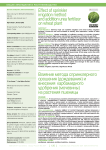
Effect of sprinkler irrigation method and addition ratio urea fertilizer on wheat plant
Статья научная
Originality/Value: Farmers must use sprinkler irrigation and avoid surface irrigation because it harms the soil and increases its salinity, also represents a waste of water resources. Research limitations: Limited availability of sufficient numbers of sprinkler irrigation devices in Iraq, their high prices, and the lack of experience of farmers to use them. The Purpose of the research is to evaluate the effect of the appropriate irrigation method and the amount of fertilizer specified for urea fertilizer that achieves the best growth for the plant and increase its productivity while avoiding a negative impact on soil properties. Research Method: Two types of irrigation: spraying and flooding, and four mineral fertilization treatments (0. 50.100. 150) kg.ha-1 were used in the work to study the apparent characteristics of wheat and the amount of productivity, using statistical analysis (Gen Stat) and simple correlation coefficient to find strength of association between variables. The experiment was carried out in 2023 at Al-Khatib Farm, located in Al-Numaniyah District, it is bordered to the south by Wasit Governorate, 50 km away, and to the north by Baghdad Governorate,160 km away (Iraq). Results and Discussion. Sprinkler irrigation showed significant differences with the surface irrigation in the length of the spike, number of seed per spike,1000 seed weight, number of spikes per square meter, grain yield kg .ha-1 and the harvest index, while the plant height was not significant. The study also showed that the correlation coefficient between the apparent characteristics of the plants was stronger in the case of using sprinkler irrigation compared to the surface irrigation.
Бесплатно
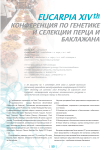
Eucarpia XIV th. Конференция по генетике и селекции перца и баклажана
Тезисы
С 30 августа по 1 сентября 2010 года в городе Валенсия (Испания) проходила международная конференция EUCARPIA XIV th Meeting on Genetics and Breeding of Capsicum and Eggplant, посвященная изучению генетических ресурсов и практической селекции перца и баклажана.
Бесплатно
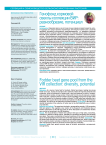
Fodder beet gene pool from the VIR collection: diversity, potential
Статья научная
Relevance. As a source of juicy feed for livestock, fodder beet plays a leading role among fodder root crops. It plays an important role to solve the problem of improving domestic feed production, since the production of fodder beet is the most balanced in terms of carbohydrate and protein complex. A large number of feed units from the area of sowing in a complex with a high yield, a balanced mineral complex and the possibility of long-term storage makes the crop in demand for the livestock complex in Russia. The VIR fodder beet collection has a rich gene pool and, given the lack of varieties and hybrids in the State Register of the Russian Federation, is a source of raw material for domestic breeding. The purpose of the study is to identify the potential of the collection of fodder beet in the most important areas of modern crop selection. Materials and methods. The experiment involved a representative sample of 190 accessions that were grown in the vegetable crop rotation of the Research and Production Base of Pushkin Laboratories of the VIR from 2015 to 2019. Description and biochemical studies were carried out according to the VIR Guidelines. Results. The characteristics of fodder beet cultivars with signs of high yield, productivity, resistance to abiotic and biotic factors, suitability for mechanized harvesting and storability were given. There was a manifestation of axenium resistance of the culture to cercosporosis due to morphophysiological characteristics of the leaf apparatus of plants. Conclusions. The VIR fodder beet collection has a wide variety and well-studied gene pool, which is the potential to create the modern varieties and hybrids of crops with a complex of economically valuable characteristics, which are necessary for their high-tech production.
Бесплатно
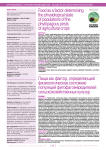
Статья научная
Relevance. Trophic relationships along with competition and mutualism are the most basic and significant interactions in ecosystems. To develop, survive, and multiply, insects need to consume a certain amount of nutrients at a certain ratio. Food products are complex mixes of nutrients and non-nutritive substances (sometimes toxic ones): macronutrients (proteins, carbohydrates, and lipids), micronutrients (vitamins and minerals), and water. Some nutrients are essential; insects lack the ability to synthesize them in their bodies and must obtain them from their diet or through symbiosis with beneficial organisms. Identification mechanisms being well developed in the system “phytophagous insect plant” allow insects to successfully spread, multiply, and feed on certainplant species. The complex of hydrolytic enzymes in the insect intestine is one of the main targets for plant defense responses because these enzymes determine the availability of structural compounds for phytophagous insects. For this reason, enzymes in the insect intestine play a key role in the adaptation of insects to the pest resistance of fodder plants. For instance, when proteinase inhibitors are synthesized in a fodder plant as the result of induced insect resistance the complex of enzymes in an insect intestine might change negating the effect of these inhibitors. The development of co-adaptations due to interactions among species in food chains depends on a complicated constellation of conflicting relationships between consumers and food objects. The mechanisms of this influence may be rooted in the allelochemical interactions in the system “phytophagous insect plant recipient”. Allelopathic interactions are among the most complex interactions because they are constituted by direct and indirect effects. Plants when damaged by phytophagous insects activate defense responses, which incorporate several mechanisms, including an increase in the concentration of secondary metabolites, many of which are phenolic compounds. The aim of the work is to describe the mechanisms of relationships in the system “phytophage-plant”.
Бесплатно
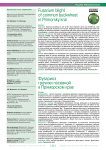
Fusarium blight of common buckwheat in Primorsky krai
Статья научная
Relevance. Common buckwheat is one of the most important cereal and melliferous crops being in demand both in Russia and overseas. Despite the fact that buckwheat has lower susceptibility to infectious diseases in comparisons with other grain and cereal crops, research on its pathogens is a topical issue considering a high disease rate for this crop in Primorsky krai. Materials and methods. The study on pathogenic composition was conducted in selective crop rotations of FSBSI “FSC of Agricultural Biotechnology of the Far East named after A.K. Chaiki” at the territory of Ussuriysky district in Primorsky krai. Indeterminate (Izumrud, Pri 7, Bashkirskaya krasnostebel'naya) and determinate (Dikul) buckwheat varieties were used for the study. Fungi were isolated from rhizoplane using water washing technique, from soil and rhizosphere via the dilution method, from leaves and root systems by accumulation in a moist chamber with subsequent transfer of culture onto selective medium. Fungal isolates were cultivated on toxigenic medium (Myro) to determine their phytotoxicity. Phytopathogenic activity of living cultures was evaluated on potato sucrose agar according to the modified method of Chelkowski and Manka . All experiments were conducted in accordance with established methods. Results. Culture filtrates of F. avenaceum and F. graminearum isolates, obtained from different anatomical parts of common buckwheat, were characterized by low toxicity, and culture filtrates of F. oxysporum isolate were highly toxic. Phytotoxicity of pathogens manifested itself not only in decrease in laboratory germination ability of buckwheat seeds, but also in inhibition of buckwheat sprout development. It proved that metabolites exerted a prolonged effect on sensitive plants. F.avenaceum, F. oxysporum and F. graminearum have pronounced phytopathogenic and aggressive properties in relation to buckwheat and test-plants in the laboratory conditions. The sum total of their studied phytotoxic properties is convincing enough to consider them potentially hazardous to buckwheat for wilt disease development.
Бесплатно
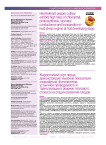
Статья научная
Relevance. Abiotic stress, as heat, significantly affect plant and floral organs growth and development, fruit set, productivity, the quality, and survival of crops. Heat injury occurs when plants are exposed to these temperatures for a long period of time. Depending on the intensity and duration of exposure to the high temperatures, photosynthesis, respiration, membrane integrity, water relations and the hormone balance of the plants may affected. Material and methods. In this study used the commercial pepper cultivar “NW Bigarim” (HT37) released in South Korea and accessions “Kobra” (HTl) and “Samchukjaere” (HT7) selected as heat tolerant and susceptible, respectively. Total chlorophyll index and photosynthetic activities measured using a SPAD meter (Konica, Japanland portable photosynthesis measurement system (LI-6400,1I-COR Bioscience, Lincoln, NE, USA), respectively. Results. To evaluate the positive effects of high temperature regime (40/28°C day/night, 14/10-h light/dark cycle) on the response of photosynthetic parameters in pepper plants with different heat susceptibility, we measured the total chlorophyll content (CHl) and photosynthetic activities such as photosynthesis (Pn), stomatal conductance to H2O (Gs) and transpiration rate (Tr) in a heat-tolerant (HT1) and -susceptible cultivars (HT7) in comparison with released cultivar (HT37) at fruit development stage. Heat-tolerant cultivars showed higher and more stable index of the CHL, Pn, Gs and Tr than those in heat-sensitive cultivars for 14 days of heat treatment (HT) period. However, the initial index of Pn, Gs and Tr showed significant alteration among pepper plants regardless of thermotolerance rate before HT on day 0 and day 7 after recovery at normal treatment condition (NT) except for CHL, meaning that plants response to high temperature regime is different from that in normal condition. These results suggest that constant high rates of Pn, Gs and Tr as well as of CHL in heat stress condition periods confer to avoid from heat injury during reproductive growth stages.
Бесплатно
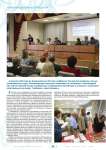
Тезисы
В августе 2008 года во Всероссийском НИИ при поддержке Российской академии сельскохозяйственных наук, Министерства сельского хозяйства РФ состоялась I Международная научно-практическая конференция «Современные тенденции в селекции и семеноводстве овощных культур. Традиции и перспективы».
Бесплатно
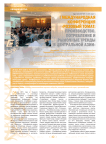
Статья научная
28 мая 2015 года в Ташкенте состоялась I Международная Конференция «Розовый томат: производство, потребление и рыночные тренды в Центральной Азии», организованная компанией SAKATA Seed Corporation. Основные вопросы, которые докладчики поднимали в своих выступлениях, - цели и направления научно-исследовательской работы и селекции розовоплодных сортов и гибридов F1 томата, проблемы, стоящие перед производителями, предпочтения потребительского спроса. Конференция стала площадкой для наращивающего обороты диалога производителей и экспортеров розовых томатов из Казахстана, Узбекистана и Испании, импортеров из России, селекционеров и менеджеров компании SAKATA.
Бесплатно

II Форум Fresh Food Russia 2011. Будущее индустрии свежих продуктов в России
Статья
10-11 ноября в гостинице Hilton Ленинградская состоялся II Форум Fresh Food Russia 2011: Свежие продукты, готовая еда в современных сетях. Fresh Food Russia стал единственным в России форумом, освещающим вопросы закупки и хранения свежей продукции, системные решения по возвратам и утилизации, логистику, организацию собственного производства, а также контроль просроченных и некачественных товаров в сетях. Впервые на площадке Fresh Food Russia 2011 состоялось вручение Национальной премии Fresh Food Awards и проведены коммерческие переговоры производителей и поставщиков свежей продукции с розничными сетями России.
Бесплатно
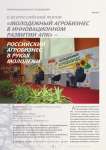
Статья
10 октября 2010 года в Москве на территории Всероссийского выставочного центра в рамках XII Российской агропромышленной выставки «Золотая осень» прошел II Всероссийский форум «Молодежный агробизнес в инновационном развитии АПК России».
Бесплатно
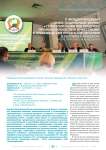
Статья
Второй Международный инвестиционный форум «Стратегия развития пищевой промышленности и инвестиции в производство в условиях кризиса» состоялся 14 октября в«Экспоцентре». В это время здесь проходила выставка «Агропродмаш2009» и форум стал одним из сопутствующих мероприятий, привлекших внимание участников выставки и посетителей. В его работе приняли участие около ста руководителей и владельцев предприятий пищевой промышленности, специалистов и учёных, экспертов, а также представители федеральных органов власти, финансовых структур, страховых компаний. Организатором выступила компания «АгроМедиаГрупп». Форум прошёл приподдержке Министерства сельского хозяйства РФ, Торгово-промышленной палаты РФ, Ассоциации региональных банков России. Партнёры Форума - ОСАО «Ингосстрах», ООО«ИндастриПак».
Бесплатно
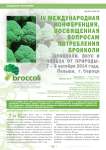
Статья
7 и 8 октября 2014 года в гостинице NARVIL Conference & Spa в г. Сероцк (Польша) при поддержке компании Sakata состоялась IV Международная Конференция «Брокколи. Вкус природы». Мероприятие было посвящено вопросам производства, маркетинга, потребления и полезных свойств брокколи.
Бесплатно
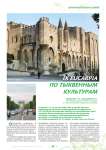
IX eucarpia по тыквенным культурам
Другой
В период с 21 по 24 мая 2008 года в городе Авиньон (Франция) проходила международная конференция «IX EUCARPIA International Meeting on Cucurbitaceae 2008», которая была посвящена генетическим ресурсам, селекции, генетике и биотехнологии тыквенных культур. В конференции приняли участие 223 представителя из 32 стран, в том числе из России.
Бесплатно
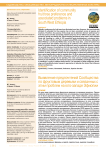
Identification of community fruit tree preference and associated problems in south west Ethiopia
Статья научная
Globally, preferences for fruit trees have fluctuated over time. However, the most desirable attribute of cultivated fruit tree species has not been consistent across all species and locations. Therefore, the purpose of this study was to determine farmers' preferences for fruit tree species and the associated problems they face in four different study sites, categorized by gender and family size. Equal sampling techniques were used in each selected study site, resulting in a total of 120 household heads participating in structured interviews. The data collected was then analyzed using SPSS version 26 software, utilizing the Mann-Whitney U and Kruskal-Wallis tests. Across the study sites, a total of fourteen fruit tree species from ten families were found to be preferred. The preference for fruit trees based on gender showed no significant difference among respondents between kebeles per woreda. However, the preference for fruit trees based on family size showed a significant difference between kebeles per woreda. The number of species preferred for their subsistence value was twice as large as those preferred for commercial reasons. The proportions of these preferred species and the percentage of observed problems with fruit trees varied significantly across the studied sites. Of all the interviewed household heads, 70% in Fenika, 36.6% in Kite, 66.6% in Shesheka, and 50% in Kometa kebeles encountered severe problems during fruit tree planting. The most common problems identified were disease or pest infestation, lack of expert support, land availability, knowledge, and access to seedlings. In order to address these issues, it is important to utilize indigenous knowledge and scientifically tested research approaches to alleviate the factors that influence farmers' preferences.
Бесплатно
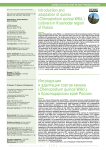
Краткое сообщение
Quinoa (Chenopodium quinoa Willd.) is a cultivated plant of the Amaranthaceae family of Peruvian origin with high nutritional value. The Krasnodar region of Russia is a region with favorable climatic conditions for growing quinoa. The studies were carried out on the basis of Quinoa Center LLC, located in the Novokubansky district of the Krasnodar Territory. Four quinoa varieties were used as research material: Blanca de Juli, White Peru, Salcedo, the local variety Seva (included in the State Register of the Russian Federation in 2017) served as the standard. Various morphological parameters of plants were assessed and phenological observations were carried out. The results showed statistically significant differences between varieties in plant productivity. The White Peru variety responded positively to the new conditions and was introduced without irrigation. The productivity of the panicle was on average 100 g, for the standard variety Seva - 70 g. In the dynamics of the ontogenetic development cycle of four quinoa varieties, it was established that the optimal sowing time in the conditions of the Krasnodar Territory is May. The tested varieties were also assessed for grain quality. In the conditions of the Krasnodar region they showed good results, thanks to selection for white grain and panicle uniformity. However, not all of them can be adapted, since they need constant watering and for late-ripening varieties autumn rains negatively affect their yield. The local early ripening variety Seva is of interest to Peru. In Peru, the main problem reducing production is low yield caused by frost in the Puno Peru region. The Seva variety reaches phenological phases: the beginning of panicle formation (R6), panicle formation (R7), flowering (R8) and full panicle ripening, physiological maturity (R12) and due to its early ripening it avoids frost. Therefore, the Seva variety can be recommended for sowing in the Puno-Peru region, since it has a gene pool that provides cold resistance but this requires detailed study. In general, to optimize the introduction of quinoa in Russia further research on adaptability in the Krasnodar region is necessary.
Бесплатно
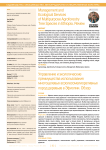
Management and ecological services of multipurpose agroforestry tree species in Ethiopia. Review
Статья обзорная
Relevance. Ethiopians have a long history of planting trees, and they have embraced the idea of keeping natural trees with many uses as a distinctive feature of their agricultural landscapes. Farmers use agroforestry practices to maintain a number of species of multipurpose trees. The selection of tree species, their intended benefits, and ecological services are inconsistent due to variability in agro-ecological conditions. The main problems with Ethiopia's multifunctional agroforestry tree species were also related to management approaches. Therefore, the purpose of this article is to examine the multipurpose agroforestry tree species in Ethiopia, their management methods, and their ecological benefits. In southern Ethiopia, Cordia africana, Millettia ferruginea, Erythrina brucei, and Olea capensis are the main multifunctional tree species used. The northern part of Ethiopia hosts Croton macrostachus, Vernonia amygdalina, Faidherbia albida, Acacia nilotica, Acacia seyal, and Grewia bicolor. The central highlands of Ethiopia are also home to Albizia gummifera, Cordia africana, Croton macrostachus, Ficus vasta, and Vernonia amygdalina. Farmers use coppicing, pollarding, and pruning tree management techniques to balance their survival with integrated crops because trees regenerate naturally. Multipurpose trees offer a range of agro-ecological services, such as improving soil fertility, mitigating erosion, mitigating the impacts of climate change, and maintaining biological diversity.
Бесплатно
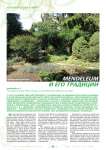
Другой
С 2 по 5 сентября 2008 года проходила V конференция по ароматическим пряно-вкусовым и лекарственным растениям среди стран юго-восточной Европы. Организатором конференции являлся Университет сельского хозяйства и лесоводства имени Грегора Менделя, кураторами конференции - факультет сельского хозяйства, факультет растенивод-ства, факультет лекарственных прераратов при Университете лекарственных препаратов и ветеринарии, Брно. В конференции приняли участие сотрудники ВНИИССОК В.А. Харченко и А.С. Домблидес, представившие постерные доклады. Место проведения конференции - Университет сельского хозяйства и лесоводства имени Грегора Менделя, является исторически важным для каждого, кто занимается селекцией и генетикой.
Бесплатно
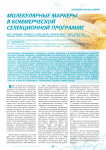
Другой
Молекулярное маркирование селекционно ценных признаков у сельскохозяйственных растений получило большое развитие в пребридинговых исследованиях 90-х годов прошлого и начала нынешнего столетия. С ДНК-маркерами, как с основными носителями информации о структуре генома, селекционеры связывали и связывают большие надежды. Однако внедрение MAS/MARS - технологий в селекционные программы в Российской Федерации крайне затруднено. Это обусловлено отчасти недостаточностью материально-технической базы, дороговизной молекулярных технологий и нехваткой кадров, подготовленных для проведения подобного рода исследований, а отчасти и неспособностью использовать на практике необходимую информацию, добытую, зачастую, весьма нелёгким путём. Участвуя в международной конференции «Традиционная и молекулярная селекция полевых и овощных культур» в г. Нови Сад (Сербия), мы познакомились с профессором Иллинойского университета Ритой Мамм, которая любезно предоставила нам доступную информацию об использовании молекулярных маркеров в коммерческих селекционных программах США. Статья была опубликована в журнале «Crop Science», №47 (S3), 2007, с. 154-163, издаваемом Crop Science Society of America (Научным обществом растениеводов Америки). Этой информацией мы хотели бы поделиться с читателями журнала «Овощи России».
Бесплатно
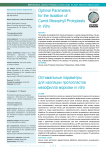
Optimal Parameters for the Isolation of Carrot Mesophyll Protoplasts In Vitro
Статья научная
The isolation of protoplasts from diverse plant species is a widely employed technique. The purpose of this work is to develop an efficient system for isolating and purifying mesophyll protoplasts from Daucus carota. Main factors influencing the qualitative and quantitative dimensions of protoplast isolation procedures attempted to be optimized, using the well-established protoplast fusion technique as the foundation for the comprehensive analysis, including sorbitol concentration during the preplasmolysis stage and the duration of the enzymolysis process, those key variables affect the yield and survivability of the protoplasts. This research employed "Vil-1" carrot leaves as the primary source material to isolate protoplasts through enzymolysis. The data revealed that higher concentrations of sorbitol led to increased protoplast yield, with the optimal concentration being 0.5 M, which resulted in up to 95% protoplast vitality. Furthermore, prolonging the enzymolysis duration to 6 hours maximized both protoplast yield and vitality. The optimal conditions for isolating protoplasts were determined to be 0.5 M sorbitol pre-treatment for one hour, combined with a mixture of 1% cellulase, 0.1% pectinase, and a 6-hour incubation period.
Бесплатно
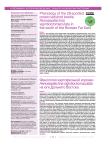
Статья научная
Relevance. The 28-spotted potato ladybird beetle, Henosepilachna vigintioctomaculata, causes severe damage to plants of the Solanaceae family in the south of the Russian Far East. Today the application of chemicals is the main method for protecting crops against the potato ladybird beetle. This leads not only to the eradication of the pest, but also to the pollution of agricultural ecosystems and the emergence of potato ladybird beetle populations that are resistant to pesticides. A study on the seasonal cycles of the development of the potato ladybird beetle may help to devise new methods for controlling this pest. Methods. We conducted laboratory experiments to study the developmental timing ofa potato ladybird beetlepopulation. The number of eggs was counted, and then the eggs were placed in Petri dishes. The number of emerged larvae was recorded on a daily basis. The hatched larvae were transferred to glass containers (hereafter rearing cages) in batches of 10. We recorded the dates of the transition from one immature developmental stage to another notingthe simultaneity of these transitions. At the onset of the pupal stage, the date was recorded and food was withdrawn from the rearing cages. Scientific observations were carried out on the emergence ofyoung beetles. Field research on the phenology of the potato ladybird beetle was conducted at afield site of 40 m2. The timing of the following events was recorded: the emergence of the adult beetles from diapause, the colonization of the potato field, the beginning and the end of oviposition, the emergence of the larvae and the pupae, the flight of the new insect generation. Results and conclusion. Our laboratory experiment on the immature developmental stages of the potato ladybird beetle revealed that the egg stage was 4-5 days in duration, the larval stage was 16-17 days and the pupal stage was 4-5 daysunder optimal conditions. We also observed deviations from the mean values, which could be conditioned by external factors. For instance, the duration of embryonic development depended either on humidity or on the time range of hatching from one egg mass. The observed deviations of the developmental timing of the larvae and the pupae were most probably due to the quantity and quality of the available food, and the presence of secondary metabolites and glycoalkaloids in it. The field research on thephenology of the potato ladybird beetle showed that there was only one generation in 2020, but two generations in 2021. After comparing climatic conditions in 2020 and 2021, we concluded that Henosepilachna vigintioctomaculata can produce two generations during dry and hot years.
Бесплатно

